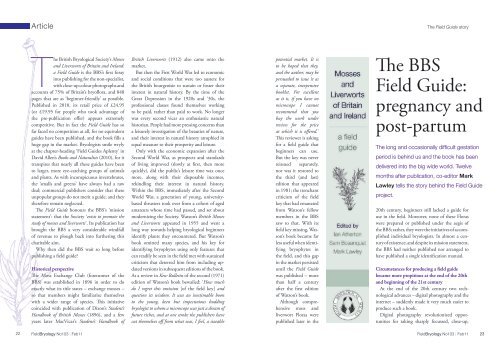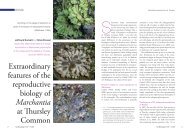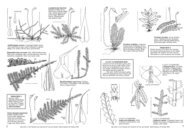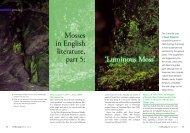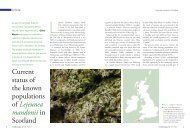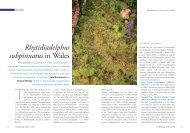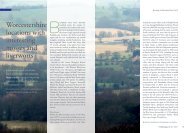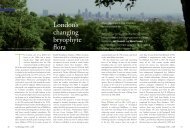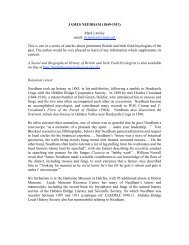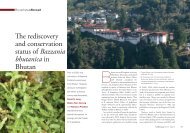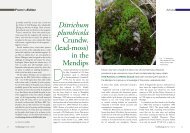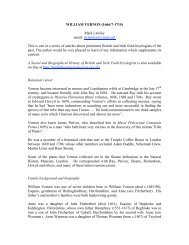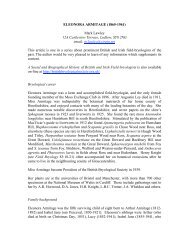The BBS Field Guide - Royal Botanic Garden Edinburgh
The BBS Field Guide - Royal Botanic Garden Edinburgh
The BBS Field Guide - Royal Botanic Garden Edinburgh
You also want an ePaper? Increase the reach of your titles
YUMPU automatically turns print PDFs into web optimized ePapers that Google loves.
Article<br />
<strong>The</strong> British Bryological Society’s Mosses<br />
and Liverworts of Britain and Ireland:<br />
a <strong>Field</strong> <strong>Guide</strong> is the <strong>BBS</strong>’s first foray<br />
into publishing for the non-specialist,<br />
with close-up colour photographs and<br />
accounts of 75% of Britain’s bryoflora, and 848<br />
pages that are as ‘beginner-friendly’ as possible.<br />
Published in 2010, its retail price of £24.95<br />
(or £19.95 for people who took advantage of<br />
the pre-publication offer) appears extremely<br />
competitive. But in fact the <strong>Field</strong> <strong>Guide</strong> has so<br />
far faced no competition at all, for no equivalent<br />
guides have been published, and the book fills a<br />
huge gap in the market. Bryologists smile wryly<br />
at the chapter-heading ‘<strong>Field</strong> <strong>Guide</strong>s Aplenty’ in<br />
David Allen’s Books and Naturalists (2010), for it<br />
transpires that nearly all these guides have been<br />
to larger, more eye-catching groups of animals<br />
and plants. As with inconspicuous invertebrates,<br />
the ‘smalls and greens’ have always had a raw<br />
deal; commercial publishers consider that these<br />
unpopular groups do not merit a guide, and they<br />
therefore remain neglected.<br />
<strong>The</strong> <strong>Field</strong> <strong>Guide</strong> honours the <strong>BBS</strong>’s ‘mission<br />
statement’: that the Society ‘exists to promote the<br />
study of mosses and liverworts’. Its publication has<br />
brought the <strong>BBS</strong> a very considerable windfall<br />
of revenue to plough back into furthering this<br />
charitable aim.<br />
Why then did the <strong>BBS</strong> wait so long before<br />
publishing a field guide?<br />
Historical perspective<br />
<strong>The</strong> Moss Exchange Club (forerunner of the<br />
<strong>BBS</strong>) was established in 1896 in order to do<br />
exactly what its title states – exchange mosses –<br />
so that members might familiarize themselves<br />
with a wider range of species. This initiative<br />
coincided with publication of Dixon’s Student’s<br />
Handbook of British Mosses (1896), and a few<br />
years later MacVicar’s Student’s Handbook of<br />
British Liverworts (1912) also came onto the<br />
market.<br />
But then the First World War led to economic<br />
and social conditions that were too austere for<br />
the British bourgeoisie to sustain or foster their<br />
interest in natural history. By the time of the<br />
Great Depression in the 1920s and ‘30s, the<br />
professional classes found themselves working<br />
to be paid, rather than paid to work. No longer<br />
was every second vicar an enthusiastic natural<br />
historian. People had more pressing concerns than<br />
a leisurely investigation of the beauties of nature,<br />
and their interest in natural history atrophied in<br />
equal measure to their prosperity and leisure.<br />
Only with the economic expansion after the<br />
Second World War, as prospects and standards<br />
of living improved (slowly at first, then more<br />
quickly), did the public’s leisure time wax once<br />
more, along with their disposable incomes,<br />
rekindling their interest in natural history.<br />
Within the <strong>BBS</strong>, immediately after the Second<br />
World War, a generation of young, universitybased<br />
thrusters took over from a cohort of aged<br />
amateurs whose time had passed, and set about<br />
modernizing the Society. Watson’s British Mosses<br />
and Liverworts appeared in 1955 and went a<br />
long way towards helping bryological beginners<br />
identify plants they encountered. But Watson’s<br />
book omitted many species, and his key for<br />
identifying bryophytes using only features that<br />
can readily be seen in the field met with sustained<br />
criticism that deterred him from including updated<br />
versions in subsequent editions of the book.<br />
As a review in Kew Bulletin of the second (1971)<br />
edition of Watson’s book bewailed: ‘How much<br />
do I regret this omission [of the field key] and<br />
question its wisdom. It was an inestimable boon<br />
to the young, keen but impecunious budding<br />
bryologist to whom a microscope was just a dream of<br />
future riches, and at one stroke the publishers have<br />
cut themselves off from what was, I feel, a sizeable<br />
potential market. It is<br />
to be hoped that they,<br />
and the author, may be<br />
persuaded to issue it as<br />
a separate, inexpensive<br />
booklet. For excellent<br />
as it is, if you have no<br />
microscope I cannot<br />
recommend that you<br />
buy the work under<br />
review for the price<br />
at which it is offered.’<br />
This reviewer is asking<br />
for a field guide that<br />
beginners can use.<br />
But the key was never<br />
reissued separately,<br />
nor was it restored to<br />
the third (and last)<br />
edition that appeared<br />
in 1981; the trenchant<br />
criticism of the field<br />
key that had emanated<br />
from Watson’s fellow<br />
members in the <strong>BBS</strong><br />
saw to that. With its<br />
field key missing, Wat-<br />
son’s book became far<br />
less useful when identi-<br />
fying bryophytes in<br />
the field, and this gap<br />
in the market persisted<br />
until the <strong>Field</strong> <strong>Guide</strong><br />
was published – more<br />
than half a century<br />
after the first edition<br />
of Watson’s book.<br />
Although comprehensive<br />
moss and<br />
liverwort Floras were<br />
published later in the<br />
<strong>The</strong> <strong>Field</strong> <strong>Guide</strong> story<br />
<strong>The</strong> <strong>BBS</strong><br />
<strong>Field</strong> <strong>Guide</strong>:<br />
pregnancy and<br />
post-partum<br />
<strong>The</strong> long and occasionally difficult gestation<br />
period is behind us and the book has been<br />
delivered into the big wide world. Twelve<br />
months after publication, co-editor Mark<br />
Lawley tells the story behind the <strong>Field</strong> <strong>Guide</strong><br />
22 <strong>Field</strong>Bryology No103 | Feb11<br />
<strong>Field</strong>Bryology No103 | Feb11 23<br />
project.<br />
20th century, beginners still lacked a guide for<br />
use in the field. Moreover, none of these Floras<br />
were prepared or published under the aegis of<br />
the <strong>BBS</strong>; rather, they were the initiatives of accom-<br />
plished individual bryologists. In almost a cen-<br />
tury of existence, and despite its mission statement,<br />
the <strong>BBS</strong> had neither published nor arranged to<br />
have published a single identification manual.<br />
Circumstances for producing a field guide<br />
became more propitious at the end of the 20th<br />
and beginning of the 21st century<br />
At the end of the 20th century two technological<br />
advances – digital photography and the<br />
internet – suddenly made it very much easier to<br />
produce such a book.<br />
Digital photography revolutionized opportunities<br />
for taking sharply focussed, close-up,
<strong>The</strong> <strong>Field</strong> <strong>Guide</strong> story<br />
colour photographs of small objects such as bryo-<br />
phytes. As recently as the 1980s only a few gifted<br />
photographers such as John Birks and Harold<br />
Whitehouse had been taking high-quality photo-<br />
graphs of bryophytes, but by the end of the century<br />
it had become possible for almost anyone<br />
to capture quality images and delete and replace<br />
substandard pictures. Moreover, pictures could<br />
be circulated by email and form part of a library<br />
for use in a corporate project such as the <strong>Field</strong><br />
<strong>Guide</strong>.<br />
Similarly transmission of text was made<br />
quick and easy by the internet and email, whilst<br />
programs such as Adobe InDesign made preparation<br />
and formatting of files and desktop<br />
publishing entirely feasible for the computerate.<br />
Development of the <strong>Field</strong> <strong>Guide</strong> to the point<br />
of publishing the first edition<br />
At the <strong>BBS</strong>’s Spring Meeting in 2004 I proposed<br />
the preparation and publication of a field guide<br />
to <strong>BBS</strong> Council in the following terms: ‘…Many<br />
natural historians who might take up bryology and<br />
join the <strong>BBS</strong> are deterred from doing so because<br />
the Society has produced no attractive, userfriendly<br />
literature for naturalists wishing to take up<br />
bryology…<br />
For eminently good and understandable reasons,<br />
the <strong>BBS</strong> is run by a Council of active and<br />
experienced bryologists whose current interests …<br />
are too esoteric to attract the public’s interest. For<br />
most of us here in this room, our own first hesitant<br />
bryological steps have long since receded into history,<br />
and with the passing of time we have forgotten what<br />
it’s like to be a beginner, unable to identify most of<br />
what one finds, so we find it difficult to empathise<br />
with the beginner’s plight. I think this is why the<br />
Society has yet to carry through a big project aimed<br />
at helping members of the general public who are<br />
interested in wildlife but remain deterred from<br />
taking up bryology by a lack of readily available,<br />
informative, and easy-to-understand publications.<br />
<strong>The</strong> <strong>BBS</strong> could and should do much more to help<br />
people take up field bryology, and the <strong>Field</strong> <strong>Guide</strong><br />
will go far towards correcting our negligence [in not<br />
doing more to foster] bryologists of the future. Of<br />
all the topics discussed by Council during my time<br />
of service as a councillor, the <strong>Field</strong> <strong>Guide</strong> will be<br />
by some long distance the most widely influential<br />
publishing venture planned by our Society, and the<br />
most important for the future development of field<br />
bryology in this country.’<br />
Later in 2004, Alan Hale agreed to start<br />
formatting files to go online, and 2005 saw the<br />
first progress reports and sample accounts of<br />
species published in <strong>Field</strong> Bryology. Ian Atherton<br />
first heard about the project through Mark Pool<br />
at a Cornwall Bryology Group meeting in early<br />
2006. In the spring of that year he offered to design<br />
and prepare files for publication, and became a<br />
co-editor. Without his professional expertise the<br />
<strong>Field</strong> <strong>Guide</strong> might never have happened. John<br />
Birks and Des Callaghan provided a critical mass<br />
of photographs. In 2007, Sam Bosanquet, who<br />
had been an enthusiastic supporter of the project<br />
and who by that time had already written many<br />
texts for species accounts, as well as providing<br />
photographs, joined the editorial team, adding<br />
huge doses of bryological expertise and authority.<br />
In 2008, 50 copies of a prototype were printed<br />
for trialling by contributors and other invited<br />
bryologists. 2009 was spent amending and<br />
updating material for the guide, proof-reading,<br />
processing pre-publication orders, and finalizing<br />
which printer to use.<br />
Investigations into how best to publish the<br />
<strong>Field</strong> <strong>Guide</strong> led to interesting exchanges with<br />
potential publishers. <strong>The</strong> <strong>Field</strong> Studies Council<br />
publish an excellent series of AIDGAP books<br />
for identifying some of the less popular groups<br />
of organisms, so in 2004 I contacted their<br />
Publishing Department at Preston Montford.<br />
However, they suggested a retail price of at least<br />
£80 for a 600 page book with 480 colour images.<br />
Such a high price might have deterred many<br />
potential newcomers to field bryology. I therefore<br />
contacted Wild<strong>Guide</strong>s, who also publish field<br />
guides. <strong>The</strong>ir price for an A5 book of 600 pages<br />
and 480 colour images would have allowed<br />
a retail price of around £30 – about a third of<br />
FSC’s.<br />
But if the <strong>BBS</strong> published the guide, might<br />
the figures be even lower than those supplied<br />
by Wild<strong>Guide</strong>s? I sought prices from a local<br />
printer that specializes in printing and binding<br />
books, and did indeed obtain prices that<br />
were significantly lower than those quoted by<br />
Wild<strong>Guide</strong>s.<br />
Later on, Cambridge University Press,<br />
hearing of our intention to publish a field guide,<br />
approached me asking if they might publish<br />
it. Unfortunately, they did not consider that a<br />
small print run for a book with colour images<br />
would be commercially viable, and envisaged<br />
a guide with black-and-white photographs.<br />
Some <strong>BBS</strong> members felt that the kudos of<br />
having our book produced by such a prestigious<br />
publishing house would make up for the<br />
absence of colour photographs. However, after<br />
careful consideration the Society’s Publications<br />
Committee decided that newcomers to the<br />
field struggling to identify unfamiliar mosses<br />
and liverworts would probably rather have<br />
colour than black-and-white photographs;<br />
subtle variations in hue are often useful when<br />
distinguishing species in the field.<br />
So self-publication by the <strong>BBS</strong> using a<br />
commercial printer seemed the best option<br />
since it allowed us to keep the price of the book<br />
low while retaining copyright and thereby the<br />
right to publish further editions when it was<br />
bryologically rather than merely financially<br />
appropriate. Above all, all profits would be the<br />
<strong>The</strong> <strong>Field</strong> <strong>Guide</strong> story<br />
<strong>BBS</strong>’s and so could be used to foster bryology<br />
instead of lining the coffers of a publishing<br />
company.<br />
Tribulations along the way<br />
When the proposal for a field guide was tabled<br />
to <strong>BBS</strong> Publications Committee in 2003<br />
and Council in April 2004, my criticism (see<br />
above) of the <strong>BBS</strong>’s record in public relations<br />
and publication of easy-to-use manuals of<br />
identification provoked indignation in several<br />
councillors, who felt there were good reasons<br />
why the <strong>BBS</strong> had never contemplated such a<br />
project. One objection was that there would be<br />
little demand: ‘We would be very lucky to sell more<br />
than a few hundred copies.’ Another complained<br />
that ‘we do not have a business plan’, and that<br />
there was ‘insufficient information in the proposal<br />
to approve publication’. Others felt that it is not<br />
possible to reliably identify many bryophytes in<br />
the field; a book could not adequately convey the<br />
‘jizz’ of a plant, and a field guide would therefore<br />
mislead people, resulting in misidentifications.<br />
One member of the Publications Committee<br />
suggested that the <strong>Field</strong> <strong>Guide</strong> should be a private<br />
venture rather than an initiative of the Society<br />
‘because of possible risks to the Society’s reputation’.<br />
Another line of argument was that ‘if we needed a<br />
field guide to bryophytes, we would have produced<br />
one before now.’ As the Reverend Sydney Smith<br />
wrote in ‘<strong>The</strong> Noodle’s Oration’ (<strong>Edinburgh</strong><br />
Review, 1802), ‘What would our ancestors say to<br />
this, Sir? … Is beardless youth to show no respect<br />
for the decisions of mature age? … If this measure<br />
be right, would it have escaped the wisdom of<br />
[our] Saxon progenitors …? Would the Dane have<br />
passed it over? Would the Norman have rejected<br />
it?’ <strong>The</strong> Publications Committee weighed these<br />
objections and decided nevertheless that the<br />
project should be backed by the Society. Many<br />
of those who expressed opposition to the <strong>Field</strong><br />
24 <strong>Field</strong>Bryology No103 | Feb11 <strong>Field</strong>Bryology No103 | Feb11 25
<strong>The</strong> <strong>Field</strong> <strong>Guide</strong> story<br />
<strong>Guide</strong> when the idea was first mooted changed<br />
their minds as the book took shape; indeed, by<br />
the time it was published nearly everyone seemed<br />
agreed that it was a good idea.<br />
Nobody was paid for their work on the <strong>Field</strong><br />
<strong>Guide</strong>, and while more than 50 members of the<br />
<strong>BBS</strong> gave time and energy to its making, several<br />
other people were unable to do so because of<br />
other commitments. ‘Worthy though the field guide<br />
is,’ one member wrote when asked to contribute,<br />
‘I am very pressed.’ Such a firm ‘no’, while<br />
disappointing, was helpful insofar as it gave the<br />
editors notice that an alternative author would<br />
have to be found. Unfortunately, other members<br />
were labouring under such acute time pressure<br />
that they could not reply to or even acknowledge<br />
invitations to contribute. Sometimes this<br />
time pressure subsequently eased, only to then<br />
worsen again; one member, for example, who<br />
failed to respond to an invitation to contribute<br />
nevertheless later spent time studying the<br />
prototype and found several ‘serious errors’<br />
in the draft. It was renewed pressure of time,<br />
presumably, which prevented this person from<br />
telling the editors what these errors were.<br />
A quite different conflict of desire arose<br />
over the kind of language to use in the guide.<br />
It was ever thus! While translating Linnaeus’s<br />
Systema Vegetabilum, Erasmus Darwin wrote<br />
to Sir Joseph Banks in 1781 that he thought<br />
English would be more vivid and precise than<br />
Latin, ‘so the words awl-pointed, for acuminatum;<br />
and bristle-pointed for cuspidatum are more<br />
expressive than the latin words. And so end-hollowed<br />
for retusum; end-notch’d for emarginatum, edgehollowed<br />
for sinuatum; scollop’d for repandum;<br />
wire-creeping for sarmentosus…’. Similarly with<br />
the <strong>Field</strong> <strong>Guide</strong>, the intention from the very<br />
outset was to eschew as much technical jargon as<br />
possible: ‘…we have adopted almost zero-tolerance<br />
of ‘bryo-babble’, and ruthlessly extirpated many<br />
terms that might deter naturalists from taking<br />
up bryology’ (<strong>Field</strong> Bryology 95, 42). It was felt<br />
that newcomers to bryology might well be put<br />
off by technical terms – ‘lanceolate’ and ‘ovate’,<br />
for example – that are rarely if ever used by the<br />
public. After all, a search of the vast 100-millionword<br />
British National Corpus, widely regarded<br />
by linguists as a representative sample of<br />
contemporary English, confirms that ‘lanceolate’<br />
is not in everyday use, being restricted to arcane<br />
technical contexts. Fortunately, ‘spearheadshaped’<br />
is more readily understood, and, according<br />
to dictionaries, means exactly the same. In<br />
<strong>The</strong> Doctor’s Dilemma, George Bernard Shaw<br />
pithily summarized the predilection to obfuscate:<br />
‘every profession is a conspiracy against the laity’.<br />
This determination to rid the <strong>Field</strong> <strong>Guide</strong><br />
of as many technical terms as feasible caused<br />
indignation amongst several experienced bryologists,<br />
who felt that not using such terms<br />
would reduce the guide’s accuracy. One member<br />
objected to ‘spearhead-shaped’ on the grounds<br />
that the term would only be appropriate in<br />
a book ‘aimed at Roman legionaries’. This<br />
objection caused some bafflement: after all, it<br />
could be argued that ‘spearhead-shaped’ would<br />
be less intelligible to these putative, bryologically<br />
inclined, Latin-speaking legionaries than ‘lance-<br />
olate’ (from the Latin lanceolatus). Meanwhile,<br />
those in the ‘Erasmus Darwin’ camp felt entitled<br />
to point out that for many social groups – be they<br />
Goths, punks, trainspotters, or bryologists – the<br />
use of certain words becomes a distinctive ‘badge<br />
of membership’ helping to make clear who does<br />
and who does not belong to the group: this use<br />
of specialized vocabulary to mark ‘in-group<br />
membership’ is well documented in the journals<br />
of socio-linguistics. At all events, the dispute<br />
rumbled on, with further skirmishes fought over<br />
‘ovate’ and ‘cleistocarpous’, for example.<br />
I have mentioned the pressures of time some<br />
<strong>BBS</strong> members experienced during the genesis<br />
of the <strong>Field</strong> <strong>Guide</strong>. Despite heroic efforts, some<br />
contributors were late in delivering their texts.<br />
Several were unable to file their corrections to the<br />
prototype as requested by the end of March 2009,<br />
or failed to respond to comments about their<br />
contributions by other people. In the autumn<br />
of 2009, six of the 20 text authors were unable<br />
to meet the deadline for checking their edited<br />
texts and sending in any further amendments.<br />
Text authors were invited on several occasions<br />
to request drawings for their accounts, but very<br />
few did so. Indeed, that is the reason why only a<br />
minority of accounts in the first edition include<br />
drawings. Likewise, several authors were unable<br />
to provide annotations for the illustrations in<br />
their accounts, or measurements for scale bars.<br />
Merchandizing<br />
(a) Pre-publication<br />
A pre-publication offer to sell the <strong>Field</strong> <strong>Guide</strong><br />
at £19.95 instead of £24.95 up to the end<br />
of October 2009 was advertised from the<br />
beginning of June 2009, when flyers were issued<br />
with <strong>Field</strong> Bryology 98 and it became possible<br />
to place orders via PayPal on the <strong>BBS</strong> website.<br />
Late in June 2009, flyers were also sent out<br />
with British Wildlife (circulation 9,000) and<br />
<strong>The</strong> <strong>Field</strong> <strong>Guide</strong> story<br />
the British Lichen Society’s Bulletin (circulation<br />
700). Even at this early stage of promoting the<br />
<strong>Field</strong> <strong>Guide</strong>, more than half the orders came<br />
from people who were not members of the <strong>BBS</strong>.<br />
By the end of July 2009, 25% of orders received<br />
had been placed online using PayPal. In August<br />
2009, a quarter-page advertisement appeared in<br />
the magazine Natural World, which goes to<br />
328,000 members of the county wildlife trusts,<br />
but did not appear to stimulate many orders,<br />
although it is possible that some people who saw<br />
the advertisement ordered copies online.<br />
Flyers were sent to members of the <strong>Botanic</strong>al<br />
Society for the British Isles in September 2009.<br />
This helped to boost orders to 1,139 copies by<br />
the end of that month, and October 2009 was<br />
the best single month for orders (see table below),<br />
as people took advantage of the last opportunity<br />
to order the guide at the pre-publication offer<br />
price of £19.95. Of every three copies ordered,<br />
two came from non-members of the <strong>BBS</strong>. <strong>The</strong>se<br />
Month Copies ordered Cumulative total<br />
2009<br />
June 257 257<br />
July 364 621<br />
August 232 853<br />
September 286 1,139<br />
October 551 1,690<br />
November 73 1,763<br />
December 61 1,824<br />
2010<br />
January 88 1,912<br />
February 258 2,170<br />
March 337 2,507<br />
April 261 2,768<br />
May 112 2,880<br />
June 230 3,110<br />
July 195 3,305<br />
August 82 3,387<br />
September 118 3,505<br />
October 129 3,634<br />
November 134 3,768<br />
December 116 3,884<br />
26 <strong>Field</strong>Bryology No103 | Feb11 <strong>Field</strong>Bryology No103 | Feb11<br />
27
<strong>The</strong> <strong>Field</strong> <strong>Guide</strong> story<br />
people had decided that they wanted to learn<br />
how to identify bryophytes, but were not suffi-<br />
ciently entranced by bryology to join the <strong>BBS</strong>.<br />
<strong>The</strong>re could not have been more copperbottomed<br />
proof that lack of a field guide had<br />
been deterring many people from taking up field<br />
bryology, or more embarrassing demonstration of<br />
this deficiency to a Society whose professed aim<br />
is to ‘promote the study of mosses and liverworts’.<br />
Not surprisingly, the rate at which copies of<br />
the <strong>Field</strong> <strong>Guide</strong> was ordered fell away after the<br />
pre-publication offer ended, and only about<br />
200 guides were ordered during November<br />
and December 2009 and January 2010, before<br />
soaring again once the guide had been published.<br />
By the time the guide went to press in<br />
December 2009, more than 1,800 copies had<br />
been ordered and paid for, which encouraged<br />
the <strong>BBS</strong> to order a print run of 3,000 copies<br />
for the first edition. About a third of these<br />
1,800-odd orders had been placed online using<br />
PayPal, and the proportion of orders paid for<br />
using PayPal increased continually thereafter<br />
(e.g. to 38% by mid-March 2010, a month after<br />
publication), for no flyers were distributed or<br />
advertisements placed after 2009, and the trickle<br />
of cheques received thereafter came mainly from<br />
government organizations and some booksellers<br />
who eschewed electronic payment.<br />
By the time that the <strong>Field</strong> <strong>Guide</strong> was published<br />
on 10 February 2010, 1,958 copies had been<br />
ordered and paid for by 1,589 individuals or<br />
organizations.<br />
(b) Post-publication<br />
Demand for the book soared and remained<br />
high in the months following publication, necessitating<br />
a second print run of 1,500 in April<br />
2010. Over 400 copies were ordered in the 5<br />
weeks following publication, and the original<br />
print run of 3,000 sold out during June 2010.<br />
Rather surprisingly, 19% of orders placed by<br />
the end of 2010 had come from people living<br />
abroad. People in Germany had ordered 119<br />
guides, followed by France (104), Netherlands<br />
(102), Belgium (87), Denmark (64), Norway<br />
(40), USA (37), Iceland (32), Switzerland (31),<br />
Sweden (28), Italy (14), Spain (14), Canada (12),<br />
Australia (12), Turkey (10), Finland (9), Czech<br />
Republic (5), Austria (4), Poland (3), Portugal<br />
(2), Romania (2), Slovenia (2), and single copies<br />
to Estonia, Hong Kong, Japan, New Zealand,<br />
Serbia, Slovakia and Uruguay. In addition, more<br />
than 150 copies had gone to Ireland (Eire), which<br />
was both expected and encouraging in view of<br />
the recent surge of interest in bryology there. Of<br />
other countries, most of South America and all<br />
of Africa are not represented, and China is also<br />
a notable absentee in view of the known interest<br />
in bryology in the Far East. It will be interesting<br />
to see if demand from the Far East gathers<br />
momentum in future.<br />
In the fortnight following publication, 20<br />
guides went to Denmark, where postings on a<br />
website appeared to stimulate considerable<br />
interest. Soon afterwards a similar flurry of<br />
orders came from France, and then at the end of<br />
March 2010 the Flemish and in July the<br />
Icelandic markets came alive.<br />
Promotional articles<br />
Promotional articles that introduced mosses and<br />
liverworts to non-bryologists were submitted<br />
for inclusion in Natural World, BBC Wildlife<br />
Magazine, and the members’ magazine of the<br />
National Trust. However, these magazines did not<br />
carry these promotional articles perhaps because<br />
more powerful interests than bryology clamour<br />
and compete for the limited space available in<br />
periodicals that find their way into millions of<br />
homes and thousands of waiting rooms. Just as<br />
commercial publishers refuse to publish field<br />
guides for unpopular groups of organisms,<br />
bryophytes aren’t, it seems, sexy enough to war-<br />
rant coverage in mainstream magazines, which<br />
therefore decline to publish anything about<br />
them, so they continue to be neglected.<br />
Reviews<br />
Of natural history publications with very<br />
large circulations, Plantlife and British Wildlife<br />
reviewed the book. <strong>The</strong> reviewer for Plantlife<br />
wrote that ‘one of [this guide’s] greatest strengths<br />
lies in its accessibility to people of all levels of<br />
bryophyte expertise’, and the reviewer in British<br />
Wildlife commented that ‘the absence of a wellillustrated<br />
field guide … is no longer the case …<br />
<strong>The</strong> British Bryological Society … has produced a<br />
superb guide … <strong>The</strong> style of writing is refreshingly<br />
free of unnecessary scientific jargon … a superb<br />
example of what can be achieved by a small<br />
society… a ground-breaking guide.’ <strong>The</strong> members’<br />
magazine of the <strong>Royal</strong> Society for the Protection<br />
of Birds also reviewed the guide favourably.<br />
Further success was achieved at the other end<br />
<strong>The</strong> <strong>Field</strong> <strong>Guide</strong> story<br />
b Far left. <strong>The</strong> huge, 10-colour,<br />
Heidelberg press at Latimer Trend<br />
in Plymouth where the <strong>Field</strong> <strong>Guide</strong><br />
was printed. <strong>The</strong> press worked<br />
continuously for over 24 hours to<br />
print some 80,000 double-sided,<br />
32-page sections. Left. Stacked<br />
sections waiting to be folded,<br />
trimmed and bound. I. Atherton<br />
of the spectrum of interested readers, by sending<br />
out complementary copies for review in more<br />
bespoke periodicals on natural history. British<br />
Lichen Society Bulletin reviewed the <strong>Field</strong> <strong>Guide</strong><br />
favourably in summer 2010 (‘amazing account<br />
… accessible to non-specialists [as well as] …<br />
aficionados… It’s enough to tempt one away from<br />
lichens …’). <strong>The</strong> review editors of the British<br />
Ecological Society Bulletin, <strong>The</strong> Bryologist, <strong>Field</strong><br />
Bryology, Irish Naturalists’ Journal, Journal of<br />
Biology, Journal of Bryology, Lindbergia, Scottish<br />
Wildlife Trust Magazine and Watsonia all accepted<br />
review copies. <strong>The</strong> review in <strong>The</strong> Bryologist<br />
appeared under the heading ‘<strong>Field</strong> <strong>Guide</strong> – Brits<br />
Lead the Way’, going on to say: ‘A high-quality<br />
user-friendly field guide is hard to find, and this<br />
publication can be used well beyond Britain and<br />
Ireland …’ <strong>The</strong> British Ecological Society’s<br />
reviewer wrote ‘This has to be one of the best<br />
thought-out guides I’ve ever used with attention to<br />
small details that make all the difference’, while the<br />
reviewer for Lindbergia ended with ‘My students<br />
love it! ’ In addition, the guide was favourably<br />
reviewed in Balsam Post, the members’ magazine<br />
of the Postal Microscopical Society.<br />
But of course it wasn’t possible to please<br />
everyone. <strong>The</strong> review in <strong>Field</strong> Bryology complained<br />
about the inclusion of many very rare<br />
species that most people are unlikely to see in<br />
Britain or Ireland, and similarly that ‘50 pages<br />
of field keys … will probably determine that plants<br />
are more often identified at home than in the field’.<br />
28 <strong>Field</strong>Bryology No103 | Feb11 <strong>Field</strong>Bryology No103 | Feb11 29
Drawings<br />
Sharon<br />
Pilkington<br />
<strong>The</strong> <strong>Field</strong> <strong>Guide</strong> story<br />
This reviewer in fact appeared to think that the<br />
<strong>Field</strong> <strong>Guide</strong> should not perhaps have been a<br />
field guide: ‘<strong>The</strong> decision to emphasize the ‘field<br />
guide’ aspect to the total exclusion of microscopical<br />
characters is questionable in my opinion’. If the<br />
<strong>Field</strong> <strong>Guide</strong> should not have been a field guide,<br />
what should it have been? His concluding<br />
sentence suggested one answer: the field guide’s<br />
success might encourage the publication of ‘that<br />
much-needed flora for beginners’.<br />
A more enthusiastic reviewer in Journal of<br />
Bryology pointed out that including rarities which<br />
can be recognized in the field ‘will undoubtedly<br />
help to bring in fresh records. In any case …<br />
bryological equivalents of Lady’s Slipper Orchid and<br />
the Large Blue butterfly merit attention, ‘flagship<br />
species’ that both inspire celebration of the natural<br />
world and remind us of its vulnerability.’ Similarly,<br />
bryologists could have justifiably complained<br />
had the general field key not included most<br />
common species.<br />
In many respects, reviews would better sum<br />
up the strengths and weaknesses of publications<br />
if they were somewhat delayed, and appeared a<br />
year or so after their subject has been published<br />
because errors, omissions and shortcomings<br />
will have become more apparent by then. This<br />
is particularly true of practical manuals such<br />
as field guides. However, a feedback facility on<br />
Alan Hale’s web page (www.bbsfieldguide.org.<br />
uk) provides everyone with a continual opportunity<br />
to post comments and suggest improvements<br />
for future editions of the <strong>Field</strong> <strong>Guide</strong>.<br />
<strong>The</strong> future<br />
A lot of people worked hard and long in preparing<br />
the <strong>Field</strong> <strong>Guide</strong>; their names can be found in the<br />
acknowledgements on page iii of the guide. <strong>The</strong>ir<br />
goodwill in putting in such extended effort with<br />
no expectation of financial gain is an enduring<br />
tribute to the spirit of cooperation and altruism<br />
within our Society. Generations of naturalists<br />
will be grateful to all those who helped to make<br />
the <strong>Field</strong> <strong>Guide</strong> happen.<br />
Immediately upon publication, people saw<br />
how much the <strong>Field</strong> <strong>Guide</strong> had been needed, and<br />
what a huge gap in the market it filled: previously<br />
bryologists and aspiring bryologists had no<br />
reasonably comprehensive, fully illustrated literature<br />
to take with them into the field. So the<br />
manual they got, with its first-class illustrations,<br />
informative text, and user-friendly keys, was and<br />
will remain a boon.<br />
Yet only after a book’s ‘honeymoon period’<br />
do its readers realize that their cup is half empty<br />
as well as half full. Shortcomings that inevitably<br />
mar any factual publication become apparent,<br />
and one starts to think about a new, improved<br />
edition. <strong>The</strong> <strong>Field</strong> <strong>Guide</strong> would be better if<br />
each leafy species had a drawing or close-up<br />
photograph of a leaf, for many of the photographs<br />
in the first edition do not adequately illustrate the<br />
shapes of individual leaves, even though these are<br />
clearly visible through a hand lens in the field.<br />
Furthermore, many photographs in the first<br />
edition do not clearly show some of the species’<br />
important distinguishing features, so should be<br />
replaced by better photographs in subsequent<br />
editions. To give one example from many<br />
instances, the account of Plagiochila porelloides<br />
mentions as a distinguishing feature the plant’s<br />
thread-like branches, so these should be illustrated,<br />
rather than leaving readers to imagine<br />
what they might look like.<br />
So the first edition is just work in progress. As<br />
better photographs and new drawings of leaves,<br />
capsules, and other features are incorporated into<br />
the files, most of the textual description in the<br />
‘Identification’ paragraph in each account may<br />
become superfluous and might be omitted in<br />
favour of additional illustrations. <strong>The</strong>n those who<br />
favour plain Anglo-Saxon and the supporters of<br />
‘lanceolate’ alike will finally be able to bury their<br />
spears and lances (but not in each other, I trust),<br />
and agree that a picture is better than any verbal<br />
metaphor.<br />
Indeed, our guide’s most influential and<br />
long-lasting contribution to bryology in future<br />
may prove to be its ability to stimulate the<br />
conviction that the book can and must be<br />
continually improved. <strong>The</strong> <strong>Field</strong> <strong>Guide</strong> became<br />
one of the first publications in natural history to<br />
fully embrace the newly available technologies<br />
of digital photography, the internet, and selfpublication<br />
by those who prepared it, thereby<br />
not only bringing a very modestly priced guide<br />
before the public, but also reassurance that it<br />
need never go out of print or fail to develop and<br />
improve further as subsequent editions appear.<br />
This publishing protocol is an ideal template for<br />
other natural history societies to copy.<br />
In addition, the <strong>BBS</strong> might now turn its<br />
ambition to preparing an equivalent, multivolume<br />
Bryoflora of Britain and Ireland, lavishly<br />
illustrated with a multitude of colour photographs,<br />
subsidized by revenue from sales of the<br />
<strong>Field</strong> <strong>Guide</strong>, and modelled as a combination of<br />
our <strong>Field</strong> <strong>Guide</strong> and the excellent and beautiful<br />
Swedish Bryoflora. Adequate funds are certainly<br />
available, for the <strong>Field</strong> <strong>Guide</strong> has already made a<br />
profit of tens of thousands of pounds (or perhaps<br />
one should say ‘surplus’ when discussing the<br />
financial performance of a charitable organization<br />
such as the <strong>BBS</strong>), and future editions (which will<br />
be much easier to produce) can earn still more.<br />
<strong>The</strong> <strong>Field</strong> <strong>Guide</strong>’s foreword, after all, promises<br />
that ‘the <strong>BBS</strong> will … publish new editions of the<br />
guide every few years’.<br />
<strong>The</strong> <strong>Guide</strong>’s foreword was written in 2009<br />
and describes bryology as a ‘backwater of natural<br />
history’. Several <strong>BBS</strong> members objected: “‘backwater’<br />
with its connotations of slow flow and<br />
stagnant water, is scarcely appropriate to the <strong>BBS</strong> I<br />
know – and hardly an enticement to join the ranks<br />
of bryologists”. Yet a society with 700 members is<br />
minute on the world’s stage, whereas if the <strong>BBS</strong><br />
matched the <strong>Royal</strong> Society for the Protection of<br />
Birds, with over a million members and therefore<br />
able to influence political decision-making, one<br />
might agree that it is mainstream rather than a<br />
backwater. It is quite understandable to like the<br />
<strong>BBS</strong> and the state of field bryology as they now<br />
are, but that need not prevent us wondering<br />
how they might be improved. How much better<br />
– more vibrant and popular – bryology might<br />
become in the best of all possible worlds. Are<br />
we happy with the status quo? Do we prefer to<br />
persist with entire counties bereft of bryologists,<br />
and most other districts lucky to have one or a<br />
few souls ploughing their lonely furrows? Or<br />
can we further ‘promote the study of mosses and<br />
liverworts’ by publishing manuals such as the<br />
<strong>Field</strong> <strong>Guide</strong>? Can we imagine a society of 7,000<br />
members instead of 700? Why shouldn’t there be<br />
as many bryologists as there are ornithologists?<br />
<strong>The</strong> question we must ask ourselves is ‘Do we feel<br />
plucky?’ Well, do we?<br />
Mark Lawley (e m.lawley@virgin.net)<br />
<strong>The</strong> <strong>Field</strong> <strong>Guide</strong> story<br />
30 <strong>Field</strong>Bryology No103 | Feb11 <strong>Field</strong>Bryology No103 | Feb11 31


